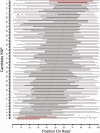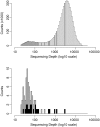Transcriptome-wide investigation of genomic imprinting in chicken
- PMID: 24452801
- PMCID: PMC3973300
- DOI: 10.1093/nar/gkt1390
Transcriptome-wide investigation of genomic imprinting in chicken
Abstract
Genomic imprinting is an epigenetic mechanism by which alleles of some specific genes are expressed in a parent-of-origin manner. It has been observed in mammals and marsupials, but not in birds. Until now, only a few genes orthologous to mammalian imprinted ones have been analyzed in chicken and did not demonstrate any evidence of imprinting in this species. However, several published observations such as imprinted-like QTL in poultry or reciprocal effects keep the question open. Our main objective was thus to screen the entire chicken genome for parental-allele-specific differential expression on whole embryonic transcriptomes, using high-throughput sequencing. To identify the parental origin of each observed haplotype, two chicken experimental populations were used, as inbred and as genetically distant as possible. Two families were produced from two reciprocal crosses. Transcripts from 20 embryos were sequenced using NGS technology, producing ∼200 Gb of sequences. This allowed the detection of 79 potentially imprinted SNPs, through an analysis method that we validated by detecting imprinting from mouse data already published. However, out of 23 candidates tested by pyrosequencing, none could be confirmed. These results come together, without a priori, with previous statements and phylogenetic considerations assessing the absence of genomic imprinting in chicken.
Figures





Similar articles
-
RNA-Seq Analyses Identify Frequent Allele Specific Expression and No Evidence of Genomic Imprinting in Specific Embryonic Tissues of Chicken.Sci Rep. 2017 Sep 20;7(1):11944. doi: 10.1038/s41598-017-12179-9. Sci Rep. 2017. PMID: 28931927 Free PMC article.
-
Global survey of genomic imprinting by transcriptome sequencing.Curr Biol. 2008 Nov 25;18(22):1735-41. doi: 10.1016/j.cub.2008.09.044. Curr Biol. 2008. PMID: 19026546
-
Parent-of-origin specific QTL--a possibility towards understanding reciprocal effects in chicken and the origin of imprinting.Cytogenet Genome Res. 2007;117(1-4):305-12. doi: 10.1159/000103192. Cytogenet Genome Res. 2007. PMID: 17675872 Review.
-
Genomic organization and allelic expression of UBE3A in chicken.Gene. 2006 Nov 15;383:93-8. doi: 10.1016/j.gene.2006.07.019. Epub 2006 Jul 31. Gene. 2006. PMID: 16996702
-
Imprinting of the mouse Igf2r gene depends on an intronic CpG island.Mol Cell Endocrinol. 1998 May 25;140(1-2):9-14. doi: 10.1016/s0303-7207(98)00022-7. Mol Cell Endocrinol. 1998. PMID: 9722161 Review.
Cited by
-
Scanning the genomes of parents for imprinted loci acting in their un-genotyped progeny.Sci Rep. 2019 Jan 24;9(1):654. doi: 10.1038/s41598-018-36939-3. Sci Rep. 2019. PMID: 30679576 Free PMC article.
-
Detection of QTL for traits related to adaptation to sub-optimal climatic conditions in chickens.Genet Sel Evol. 2017 Apr 20;49(1):39. doi: 10.1186/s12711-017-0314-5. Genet Sel Evol. 2017. PMID: 28427323 Free PMC article.
-
Allelic expression of mammalian imprinted genes in a matrotrophic lizard, Pseudemoia entrecasteauxii.Dev Genes Evol. 2016 Mar;226(2):79-85. doi: 10.1007/s00427-016-0531-x. Epub 2016 Mar 4. Dev Genes Evol. 2016. PMID: 26943808
-
Expanding Duplication of Free Fatty Acid Receptor-2 (GPR43) Genes in the Chicken Genome.Genome Biol Evol. 2015 Apr 24;7(5):1332-48. doi: 10.1093/gbe/evv072. Genome Biol Evol. 2015. PMID: 25912043 Free PMC article.
-
Regulatory and evolutionary impact of DNA methylation in two songbird species and their naturally occurring F1 hybrids.BMC Biol. 2024 May 29;22(1):124. doi: 10.1186/s12915-024-01920-2. BMC Biol. 2024. PMID: 38807214 Free PMC article.
References
-
- da Rocha ST, Ferguson-Smith AC. Genomic imprinting. Curr. Biol. 2004;14:R646–R649. - PubMed
-
- Holman L, Kokko H. The evolution of genomic imprinting: costs, benefits and long-term consequences. Biol. Rev. Camb. Philos. Soc. 2013 (doi: 10.1111/brv.12069; epub ahead of print, October 28, 2013) - PubMed
-
- Haig D, Graham C. Genomic imprinting and the strange case of the insulin-like growth factor II receptor. Cell. 1991;64:1045–1046. - PubMed
-
- Moore T, Haig D. Genomic imprinting in mammalian development: a parental tug-of-war. Trends Genet. 1991;7:45–49. - PubMed
Publication types
MeSH terms
LinkOut - more resources
Full Text Sources
Other Literature Sources

